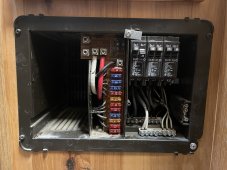John Frum
Tell me your problems
- Joined
- Nov 30, 2019
- Messages
- 15,233
Assuming the parralax unit is rated for 45 amps.One last stupid question - it’s probably a 10-12’ run from my dc stuff to the dc panel. Am I just running a hot and grounding to chassis or am I running both pos and negative back to my batteries?
45 amps at 50 feet round trip at 12 volts gives 2.4% voltage drop at 12 volts.
Interactive Wire Size Calculator
Battery Chargers, Inverters, Solar Components, and Wiring Supplies for Boats, RVs, and Off-Grid Applications.




